ARCHITECTURAL PROJECTS
LANDSCAPE
11 January, 2013
Renovation of the Dock A' of the Thessaloniki Port
The project of the reformation of the dock A' in the port of Thessaloniki, concerns two parallel levels of intervention. The first one is about the conservation of the existing infrastructure and the second one is about the restoration, exhibition and reuse of the historic area, i.e. the open air public space and the historic buildings that belong to the Thessaloniki Port Organization. (Architects Kyriaki Oudatzi)
INTRODUCTION - GENERAL INFORMATION
The aim of the intervention is the restoration and the exhibition of the architectural style and of the historical materials -both elements of our cultural heritage- the creation of functional, vivid and viable public space, in order to be given to the public for general use and, finally, the restoration of the form of the buildings which has dramatically changed from previous interventions. The restoration study shows the different historic phases of the buildings and aims to result to their functional and formal embodiment in the historic area.
The architectural restoration project was based on: a) the elements that came up from the research in historic archives and in private photographic collections and b) the detailed historic documentation which included information about the formal, typological, logistical, aesthetic and historic being of the cultural heritage of the spot and of the city, in general.
Few information is known today about the physical configuration of the area around the dock A' of the modern port where only one small quay was existed during the period of the Ottoman rule. Testimonials and abstractly given engravings of 17th century (from 1685 to 1687, when the oldest dating presumption) allow only speculate on the possible existence of a fortified point outside the walls to protect the market and the harbor. In 1876, the part of the sea wall, at the height of nowadays Venizelou Street was demolished, freeing the point where were built the first dock. In 1917, the coastal area of the city was reshaped to put a railway line that connected the port to the train station. Traces of these railway tracks, which still survive in the port, are the only authentic ones that still remain in the city. Along with the first tracks, at the first and the third dock, these are the only authentic ones -of old cobbled pavement- saved, at the city.
Initially, the dock A', hosts uses mainly administrative in nature, while, in the late nineties, following the granting of historic buildings-warehouses in cultural institutions and museums, became a zone of cultural and recreational uses, preserving memories and testimonials from past functions and activities within the very few buildings, in which, nevertheless, has not given new, permanent ones (e.g. old pumping station)
The dock A' is characterized by a group of buildings, listed as worth cultural heritage, traditional buildings, which are characteristic kinds of different eras and architectural styles, inseparably interconnected but mainly connected to the history of the city. It is noteworthy that the area of the dock A', in full contrast with other parts of the urban fabric, preserves its original character, with minimal interventions, such as the incorporation of postmodern architectural elements at the store that was used as a nursery and the demolition of the three pre-existing neighboring warehouses. The relationship of the city to the harbor, is undeniably one indissoluble relationship, historical and timeless, important for its growth during the centuries, not only because of the boom of commerce, but also because of the continuity that characterizes the functional and perceptual relationship existing between them, since the eastern part of the port is the terminus of the historic and commercial center, as the latter was configured during the last two centuries, while at the same time is the limit of the coastal zone. The dock A' was designated a historic site, with LAW7779/1994, 4589/1996 and 6405/2001 and the buildings of warehouses 1, A, B, C and D, were declared by the same ordinances listed as preservable, by setting specific conditions and restrictions layout.
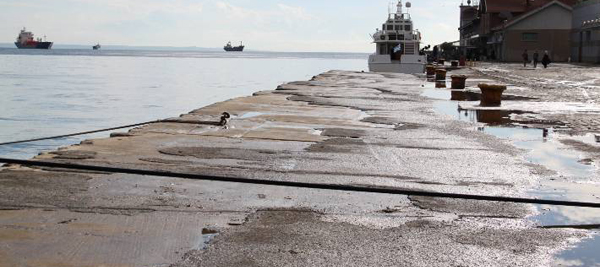
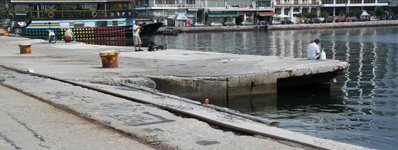
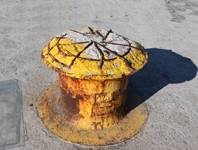
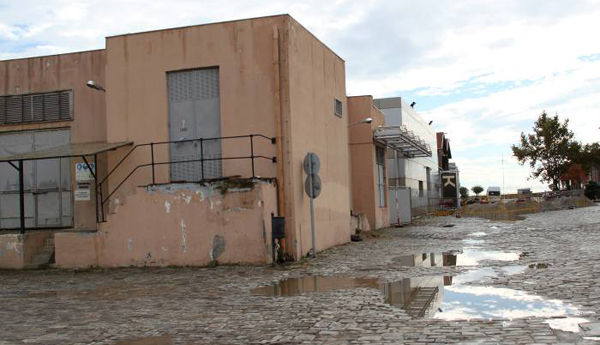
DESCRIPTION OF THE ARCHITECTURAL PROJECT
Principles of synthesis
- new, low profiled, interventions in the urban space
- creation of public space, which will be characterized by functionality and also by dialectic and transparent relationship between the new architectural interventions and the historic site through a low profile integration of modern, plainly designed materials and a creation of new structures and landmarks.
- low profile expansion of the architectural expression and the sculptural feeling of the architect, with small, subtle constructions compatible with the historic place materials such as peacefully colored pavements, new plain-shaped seats and access and land-marking luminaries, with the only exception that of the climax of architectural manipulations made at the end of the central path - to the point that is not interrupted nor the continuity of the historical front but not even the prospect of the liquid component - by the placement of the metallic architectural sculpture, which marks the boundary of the new interventions, while creating a new point of view of the open horizon.
- functional and perceptual connection of the historic site to the city, to the sea front of buildings and to the water element.
- creation of new, subtly demarcated paths, optical escapes and signs of recreation and viewing.
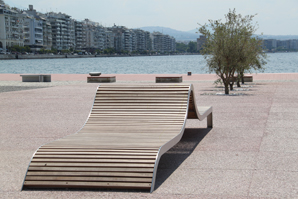
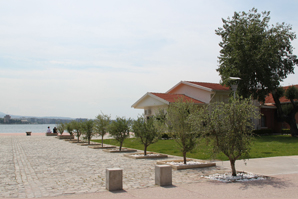
Photo 1,2.
ARCHITECT'S WORDS _ PORT GATE = CULTURE transPORTationS
The aim of the project of the low profile renovation and exhibition of the total area of the dock was to reconnect, functionally and perceptually, the historic area with the city and to exhibit the urbanity of the port. A parallel aim was to recover the building ridge of the original forehead, on the south side of the dock, which has being interacted with the coastal front of the city skyline, as the latter was designated by the buildings of the old pumping station, the military depots (photo 3) and the three neighboring warehouses that were demolished at the beginning of the last century. The functional "penetration" and connection of the urban network of the city with the port is achieved through low profile configurations and new plain and ''silent'' interventions and constructions, such as the widening of sidewalks for seamless movement of pedestrians and disabled people, the banning of vehicle movement, the marking of motion, the dense plantings, the installing of highlight lighting etc., giving the port the features of a viable public space.
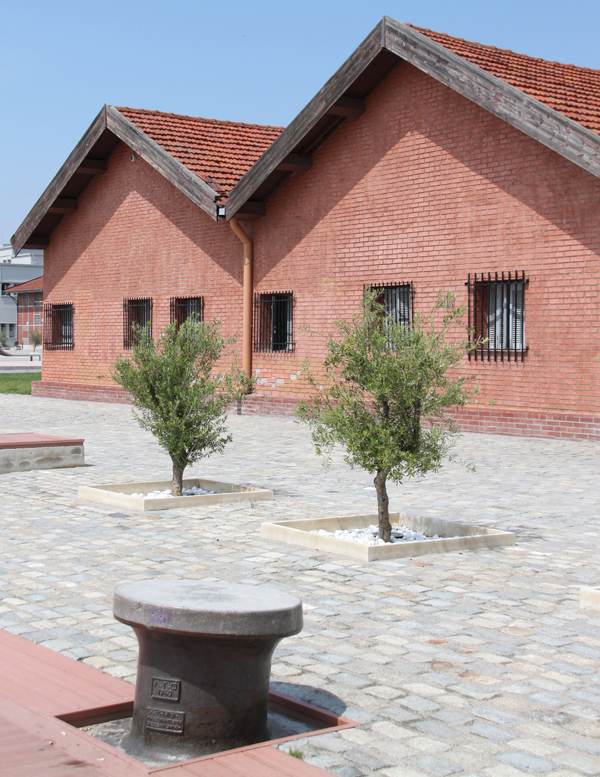
Photo 3.
The entrance from the town to dock A', remained as it was -according to the desire of the port authorities- with unique interventions, the embellishment of the facades of the two entrance outposts and the widening of the passage of pedestrians, left and right of the main gate (photo 4). Furthermore, the access to the main gate was redesigned and the sidewalk outside the port was widened, in a functional and perceptual continuity with the recent formation of the modern quay in order to facilitate the transition of pedestrians and cyclists to the dock, while, with this expansion, the site was aesthetically upgraded, since the existing parking area that constituted an aesthetic obstruction of visual escape from Eleftherias Square to the dock was removed. The recovery of the coastal front was confronted with a project of installing containers in a mounting tandem arrangement - dominant features for the port - on the traces of the three pre-existing warehouses. The synthesis of the five, double-height, successively arranged containers forms a single glass facade that will act as a large, interactive projection screen for the highlighting of events, and moreover, for the projection of the port to the city.
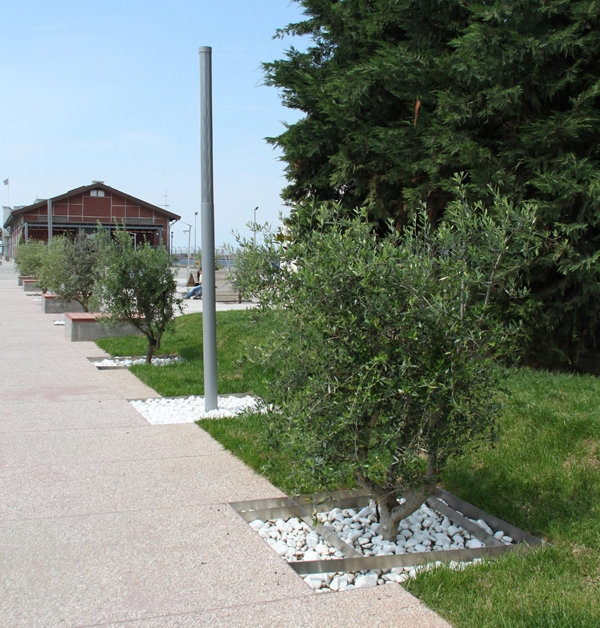
Photo 4.
Within the dock, new routes for pedestrians and special configurations to accommodate people with disabilities were created, as well as large areas with seats (photo 5), while it was facilitated the controlled access of bicycles to it in a way that does not impede the free movement of pedestrians, designating at the same time parking areas for bicycles. The central path of the new walkway, as well as the entire area of the intervention was covered with the original, authentic cobblestones after the restoration of the substrate and all underground infrastructure networks, since some of the main city networks pass underneath.
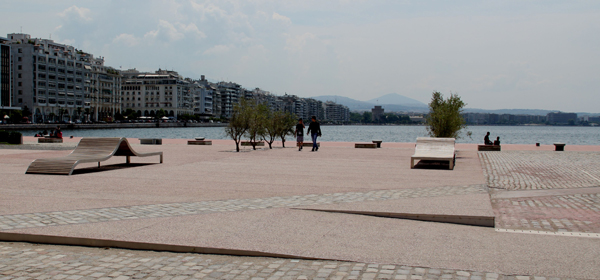
Photo 5.
Along with the new paving, the problem of rainwater was resolved by redesigning slip water basins. The linearity of the central route, defined by the original parallel layout of the location of the historic buildings, was emphasized even further by the dynamic widening and change of the original alignment of both sides of theses movement areas. From the pre-existing sidewalks, were removed all the coatings and the plates which had an extravagant aesthetic and belonged to subsequent historic phases. These plates were replaced by cast flooring with cobbles in a ceramic color (photo 6) in order to be created - in harmony with the setting of the third dimension of the reformation - a single and calm chromatically total, accordant to the historic buildings whose faces are made with overt bricks. The path of pedestrians is marked, with planting of olive trees (photo 7) in a linear form, a selection compatible with the Mediterranean climate and landscape.
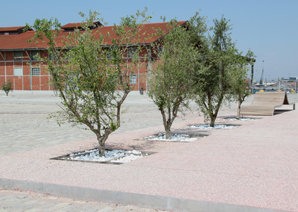
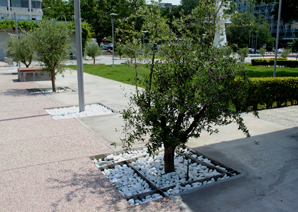
Photo 6,7.
When someone enters the heart of the historic site, follows the route which is designated by the historic buildings themselves. The course of this main route which maintains the same austere alignment is emphasized by the neutral colored covering materials and the nonskid textured marble of a conformable aesthetical color, that of the natural cobblestone. This route is characterized by the special carving that exists in each pathway in order to facilitate the disabled people. In the same direction, a subterranean drain pipe was set to resolve the problem of lagoons on the cobblestone, which constantly incommode the walking of pedestrians, especially during winter. On both sides of the main route, were set alternately and in a linear configuration, olive trees and seats, while the entire walkway is emphasized by special illumination [path illumination for the marking of its sides (photo 8), ''wall washing'' and theatrical illumination for the highlighting of the buildings and trees (photos 9,10)].
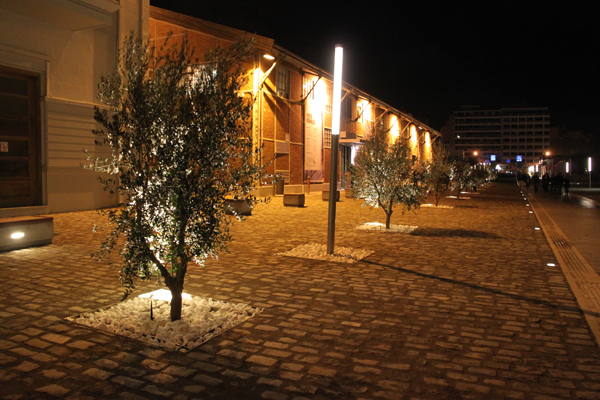
Photo 8.
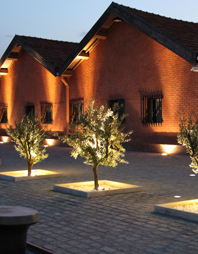
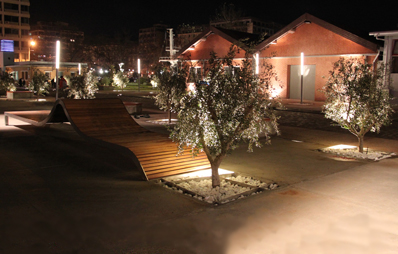
Photo 9,10.
The end of this route is marked by an artistic, architectural construction-urban sculpture (photos 11-13) which is formed by two parallel, metallic panels of unequal height which were symbolically "penetrated" by abstract and minimalistic shapes of birds which convert the dense and lively corresponding image standing at the end of the route, that of the horizon into an artistic intervention, adding in this manner an aesthetic touch to the so far indifferent and abandoned spot. By the scenographic movement of birds, which is enhanced by a continuous flow of specific density colorful liquids, even in the evening hours, it is maintained the dynamics of the place and becomes intensely experiential through the direct, calm and strong contact relationship with the sea and the horizon, the theatrical illumination of the panels and the movement of the liquid element. Finally, the same panels, lead to a stepped platform, which is de-escalated smoothly, giving visitors the opportunity to use it as a point of relaxation and enjoyment of the open horizon of the region, and sometimes as a platform hosting outdoor events.
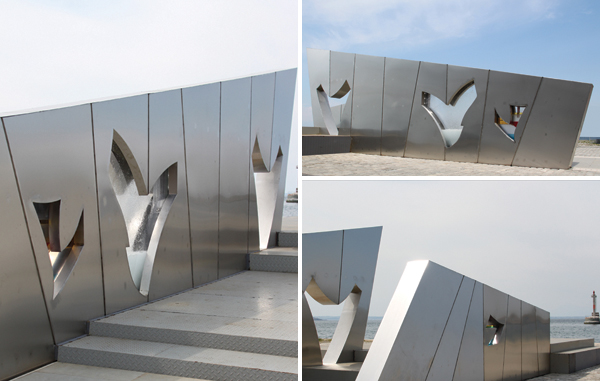
Photo 11,12,13.
The route which opens immediately after the entrance to the dock and on the left, with visual escape to the town (photo 2) was also covered with the original paving blocks and leads through a similar, linear in form, alley to the expansion constructed at a later time than the original dock. The original concrete floor was reconditioned and after formation of the slopes for drainage of sea water, was lined with natural wood deck while special lights -accompanied by seats- that were placed at the ends, designated, for safety reasons, the boundaries. All along the coastline, concrete seats coated with wood alternate with parterres of olive trees, turning the originally unformatted area into a gathering spot for the public and a point of unique viewing of the most impressive front of the city, the zone of the coastal forehead. In what concerns the area around the building that housed, until today, the port office services, the paved unformed parking area was redesigned and converted into a square, using tree-plantings and large-scale constructions of seats-sculptures, which add by their shape, plasticity in space (photos 1,14). Cars, except emergency vehicles such as ambulances, fire trucks, etc., were excluded completely from the area, in order to acquire the characteristics of an exclusively used, pedestrian pathway.
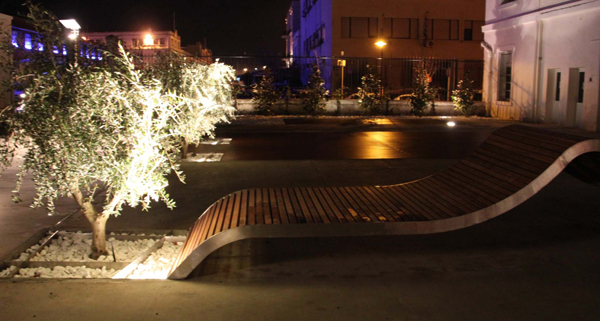
Photo 14.
The careful selection of the new materials used for the reformation, helps to maintain the aesthetic balance between the new interventions, and the historic site as well as to remove verbalistic ways of thinking and ambitious architecture writing, since the sole objective is the restoration of calmness and authenticity of the landscape and the smooth integration of new uses, without altering the historic identity of the area. Thus, materials such as stainless steel, cobbled and cast floor, marble and wood were selected, all in neutral tones and with key selection criterion, the aesthetic compatibility with the historic image, the visual calmness and the clarity of the contemporary identity of the new intervention. Respectively, the proposed interventions for the buildings are low-profile in nature, aiming at the respect of all of their historical phases while removing later additions, obvious electrical machinery and other structures that alter the character and scale of the area.
Finally, within the limits of the dock, at the end of the route and at the best viewing angle from the center of the city, on the same spot where once operated the cargo shipping system of the port, was put a crane (photo 15) -of unique historical value, a subject of industrial heritage- dating from the early 20th century, that symbolically refers to the original use of the dock, taking the characteristics of a landmark -especially in the evening because of the play of light- of the intervention area and of course of the port itself.
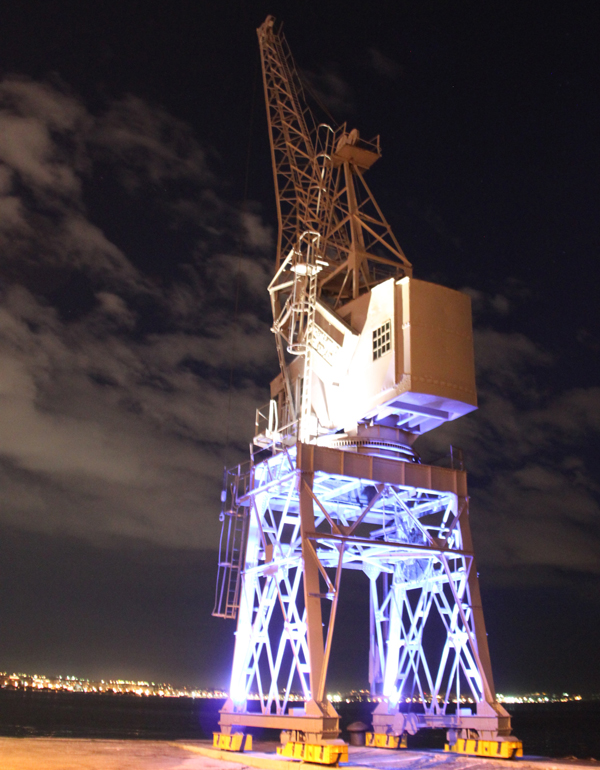
Photo 15.
PROJECT DETAILS
Project: "Renovation of the Dock A' of the Thessaloniki Port"
Employer: Thessaloniki Port Authority
Construction: Thessaloniki Port Authority
Architectural design & restoration of historic site and buildings / Lighting & General supervision of the construction project: Kyriaki Oudatzi, PhD Architect A.U.Th. Lecturer (P.D.407/80) A.U.Th. PhD & Msc Conservation of Historic Towns and Buildings, D.U.Thrace & K.U.L., Leuven, Belgium.
Study period: October - December 2010
A' phase construction period: January 2011 - June 2011
B' phase construction period: August 2011 - March 2012










